Cereals Situation in Sultan Kudarat Province, 3rd Quarter 2024

PALAY PRODUCTION AND AREA HARVESTED
The total volume of production of palay in Sultan Kudarat Province for the Third Quarter of 2024 reached 134,125 metric tons, which is 2.24 percent lower than the 137,205 metric tons recorded in Third Quarter 2023. On the other hand, the total area harvested increased from 32,456 hectares in Third Quarter 2023 to 33,280 hectares in Third Quarter 2024 or by 2.54 percent as shown in Table 1.
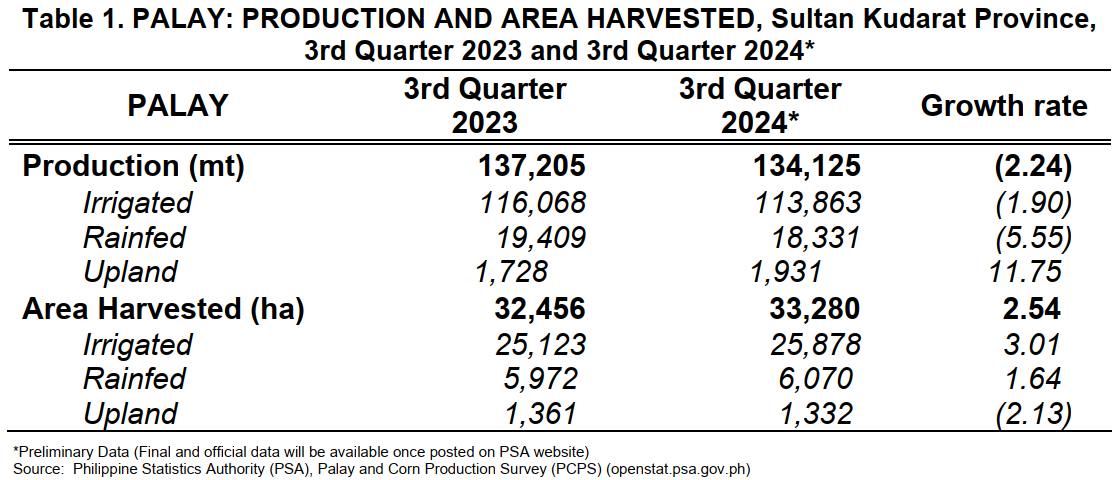
Production
• Refers to quantity produced and actual harvest of a particular crop during the reference period.
• It includes those harvested but damaged, stolen, given away, consumed, given as harvesters’
and threshers’ shares, reserved, etc.
• Excluded are those produced but not harvested due to low price, lack of demand and force
majeure or fortuitous events, etc.
Area Harvested
• The actual area from which harvests are realized.
• This excludes crop area totally damaged.
• It may be smaller than area planted.
IRRIGATED PALAY
Irrigated palay production fell by 1.90 percent or 113,863 metric tons in the Third Quarter of 2024, compared to 116,068 metric tons in the same period in 2023 (Figure 1). On the other hand, the area harvested grew from 25,123 hectares in Third Quarter 2023 to 25,878 hectares in Third Quarter 2024 (Figure 2).
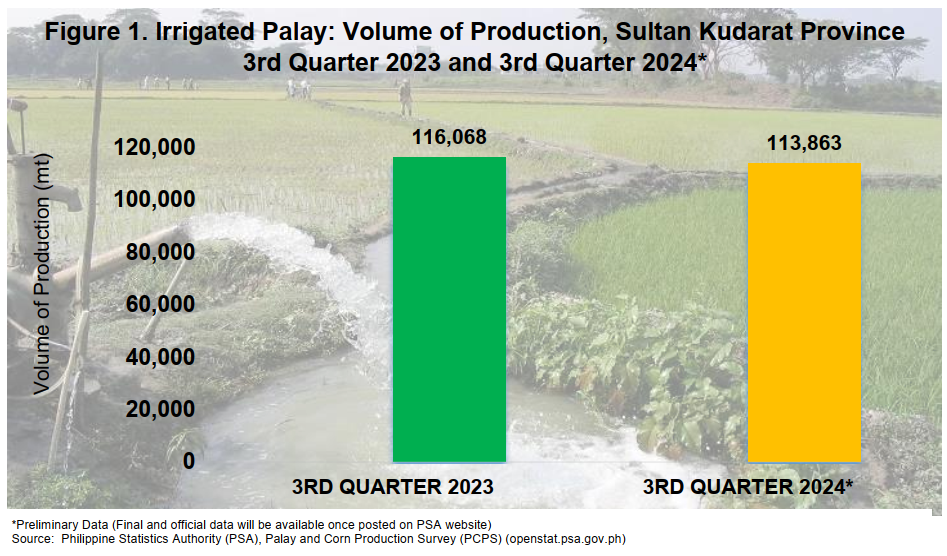
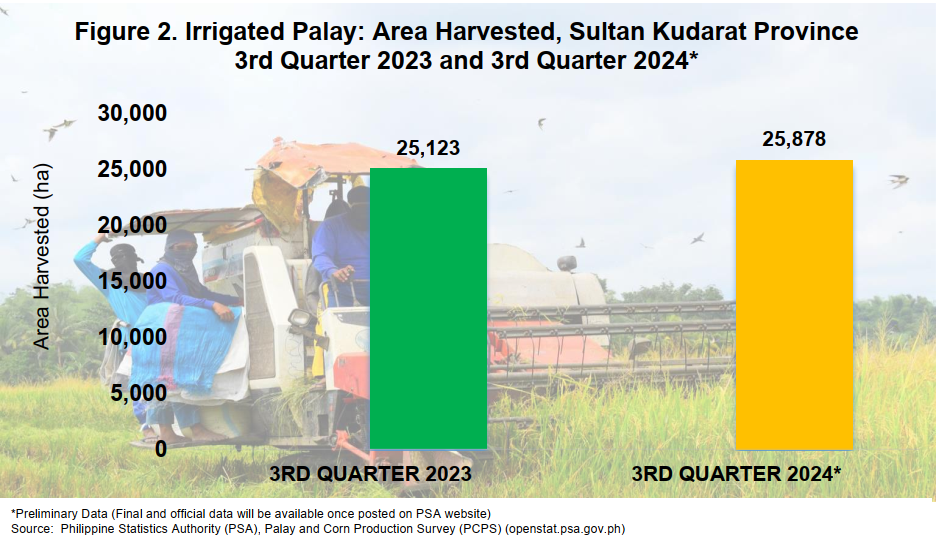
Irrigated Palay
• Palay which needs standing water for its normal growth.
• It is one that requires irrigation water made available through artificial means (gravity, force,
power pumps, etc.).
• It is not confined to lowlands but also to higher places where paddies are built for planting palay.
RAINFED PALAY
Rainfed palay production totaled 18,331 metric tons in the Third Quarter of 2024, a 5.55 percent decrease from 19,409 metric tons in the Third Quarter of 2023 (Figure 3). Meanwhile, the area harvested increased from 5,972 hectares in the Third Quarter of 2023 to 6,070 hectares in Third Quarter of 2024 (Figure 4).
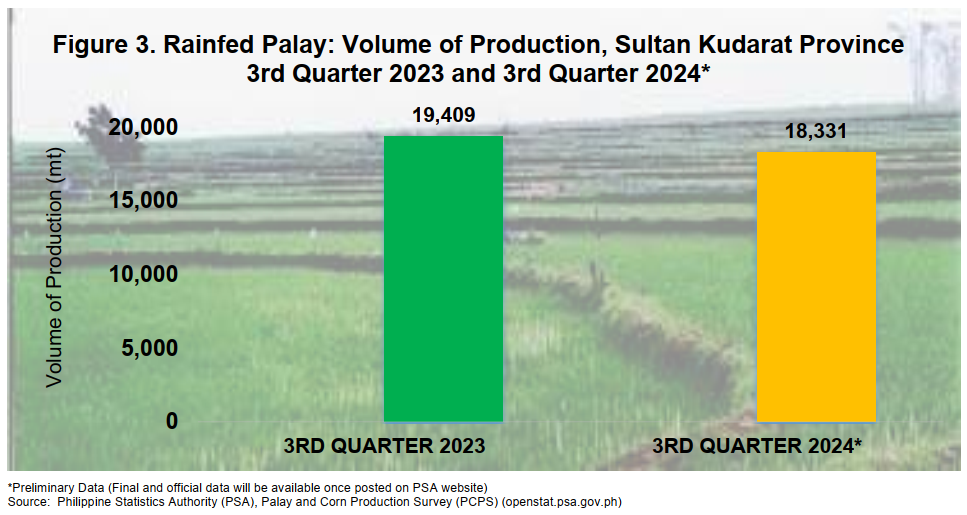
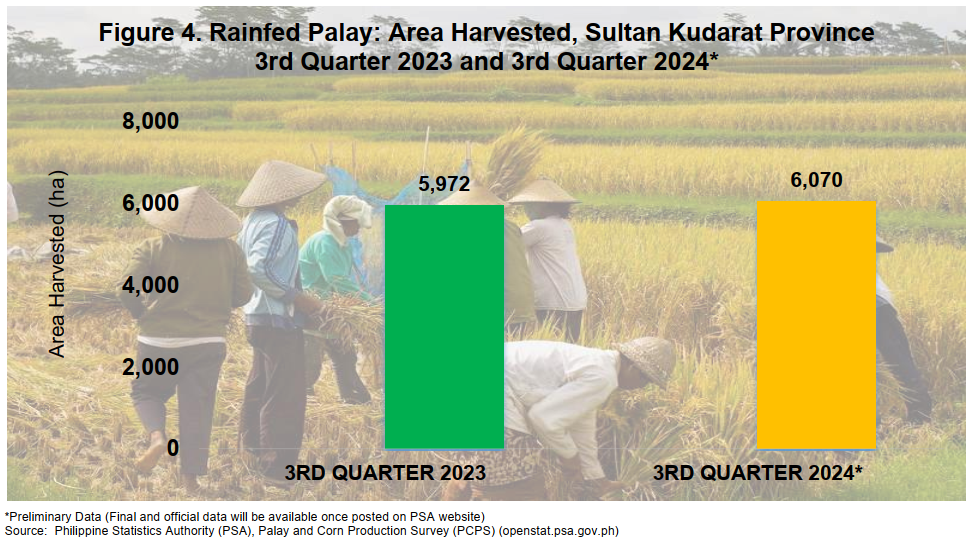
Rainfed Palay
• Palay grown on this ecosystem has dikes that retain water and is solely dependent upon
rainfall for its water supply.
UPLAND PALAY
The total upland palay production recorded 1,931 metric tons in the Third Quarter of 2024, an 11.75 percent increase from 1,728 metric tons in the Third Quarter of 2023 (Figure 5). On the other hand, the area harvested dropped from 1,361 hectares in the Third Quarter of 2023 to 1,332 hectares in Third Quarter of 2024 (Figure 6).
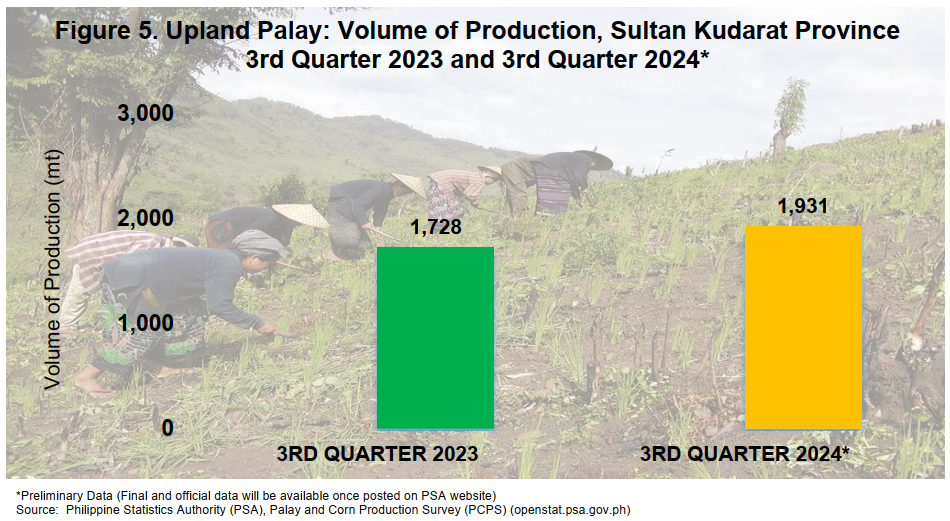
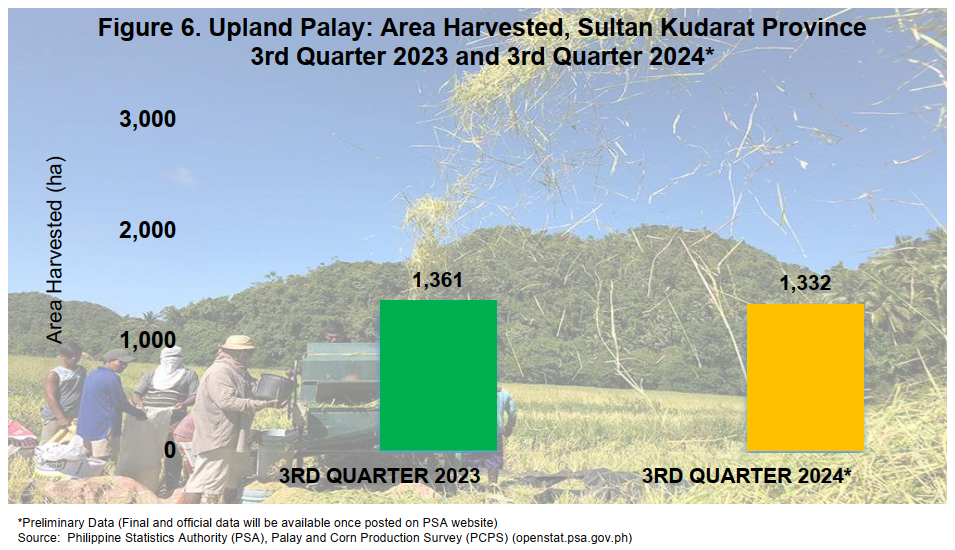
Upland Palay
• Upland palay does not require standing water for its normal growth and is usually grown
on soil usually dry on the surface.
• It also depends only on rainfall. Both are not necessarily confined to lowlands but also to higher places or hillsides.
CORN PRODUCTION AND AREA HARVESTED
The total volume of corn production in Sultan Kudarat Province for the Third Quarter of 2024 was 76,780 metric tons, a 1.87 percent less than the 78,240 metric tons reported in the Third Quarter of 2023. Meanwhile, the total area harvested grew from 25,029 hectares in the 3rd Quarter of 2023 to 25,351 hectares in the Third Quarter of 2024, or 1.29 percent, as indicated in Table 2.
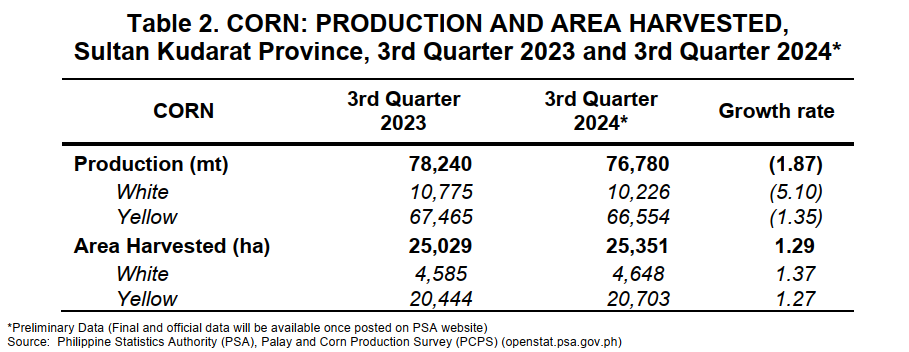
WHITE CORN
White corn production decreased by 5.10 percent, or 10,226 metric tons, in the Third Quarter 2024, compared to 10,775 metric tons in the same period in 2023 (Figure 7). Meanwhile, the area harvested increased from 4,585 hectares in Third Quarter 2023 to 4,648 hectares in Third Quarter 2024 (Figure 8).

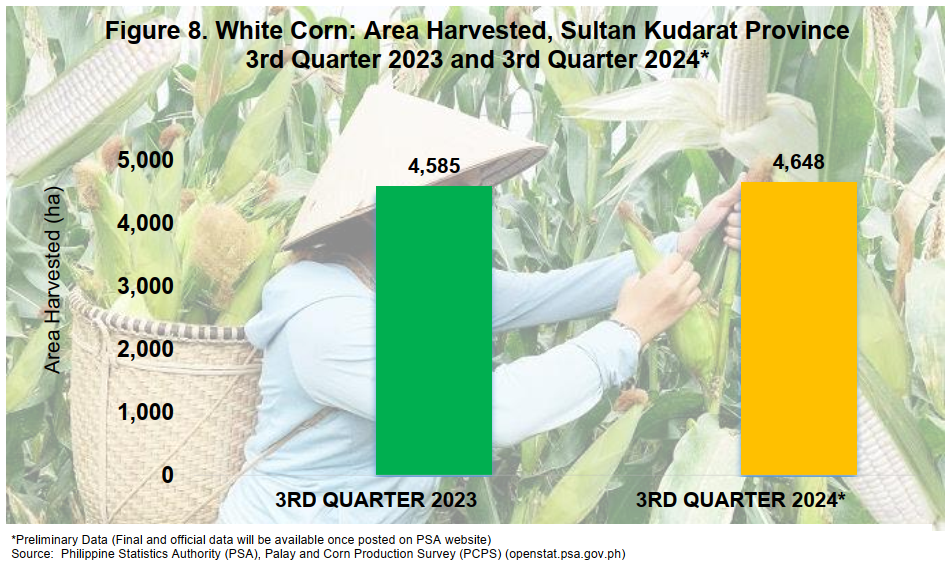
White Corn
• Corn kernels of white color with no more than two percent (2%) of other colors.
YELLOW CORN
Yellow corn production declined by 1.35 percent, from 67,465 metric tons in Third Quarter 2023 to 66,554 metric tons in Third Quarter 2024 (Figure 9). In contrast, the area harvested increased by 1.27 percent, from 20,444 hectares in the Third Quarter of 2023 to 20,703 hectares in the Third Quarter of 2024, as illustrated in Figure 10.

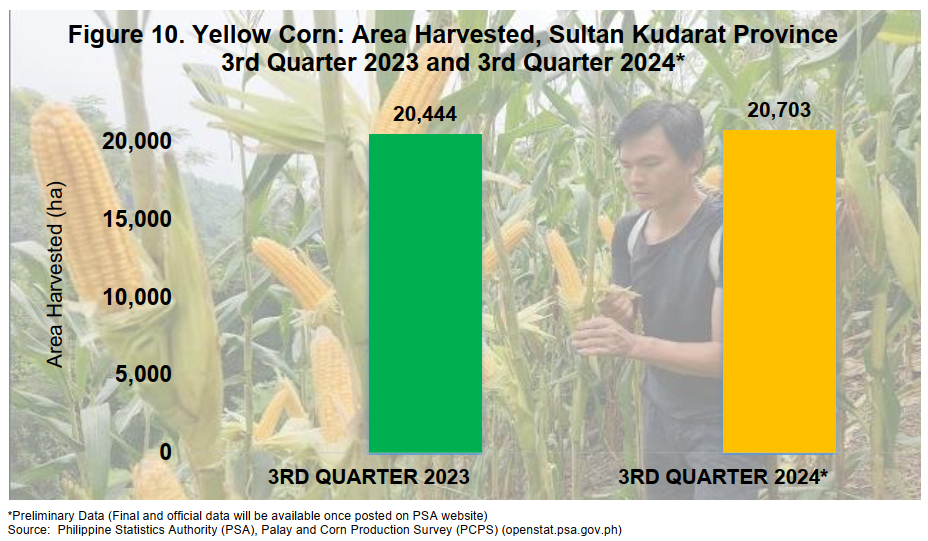
Yellow Corn
• Yellow corn kernels with not more than two percent (2%) of other colors.
• A slight tinge of other colors, other than yellow, shall not affect their qualification as yellow corn.
Approved for Release
MARIFI P. DE ASIS
OIC-Chief Statistical Specialist
Philippine Statistics Authority
Sultan Kudarat Province

